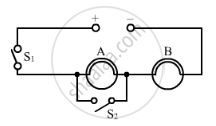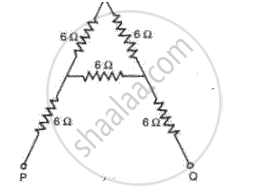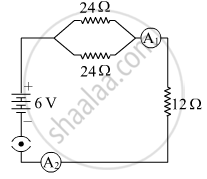Advertisements
Advertisements
प्रश्न
Compare how an ammeter and a voltmeter are connected in a circuit.
उत्तर
The ammeter is connected in series with the circuit in which the current is to be measured, whereas the voltmeter is connected across the points where the potential difference is to be measured.
APPEARS IN
संबंधित प्रश्न
The work done in moving a unit charge across two points in an electric circuit is a measure of:
(a) current
(b) potential difference
(c) resistance
(d) power
Which of the following equation shows the correct relationship between electrical unit?
1A = 1C/s or 1c= 1A/s
Ten bulbs are connected in a series circuit to a power supply line. Ten identical bulbs are connected in a parallel circuit to an identical power supply line.
(b) In which circuit, if one bulbs be brighter?
Using the circuit given below, state which of the following statement is correct?

(a) When S1 and S2 are closed, lamps A and B are lit.22
(b) With S1 open and S2 closed, A is lit and B is not lit.
(c) With S2 open and S1 closed A and B are lit.
(d) With S1 closed and S2 open, lamp A remains lit even if lamp B gets fused.
Find the effective resistance in the following circuit diagrams (Fig.):

The following appliances are to be used on 240 V supply. Calculate the current used by each and say which fuse, 2 amp, 5 amp or 13 amp should be incorporated with each, (i) A television rated at 150 W, (ii) An electric iron rated at 750 W, (iii) An immersion heater rated at 3000 W, (iv) A hair dryer rated at 500 W. How much will it cost to run the television set for 100 days for an average of 4 hours a day at 60 paise per unit?
60 joules of heat was dissipated in a resistor when 20 C flowed for 5 s. Calculate:
(a) P.d. across the resistor,
(b) Resistance of the resistor, and
(c) Average power dissipated in the resistor.
Two electric bulbs rated 100 W; 220 V and 60 W; 220 V are connected in parallel to electric mains of 220 V. Find the current drawn by the bulbs from the mains.
Study the following circuit and find out:
(i) Current in 12 Ω resistor.
(ii) The difference in the readings of A1 and A2, if any.

